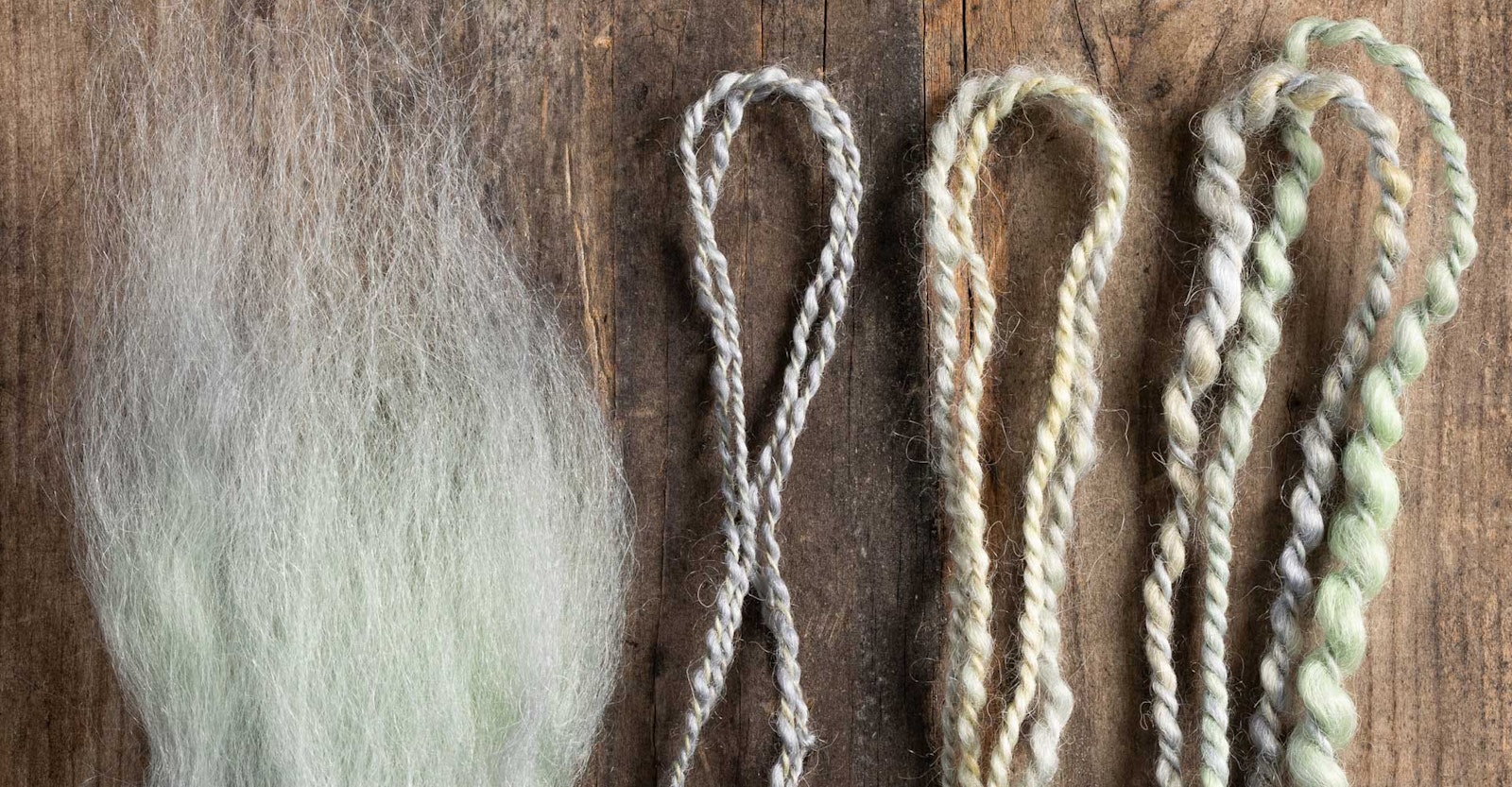Spiral yarns are quite possibly my favorite types of yarn to create. I enjoy seeing the mesmerizing cascade of coils undulating from my basket of handspun. Although I admit that many of my handspun yarns remain in my basket for quite some time before becoming finished objects, the sense of energy in my spiral yarns makes them feel as though they’re begging to be used! They’re the wiggly students in class, yearning to participate.
Gimp yarns can be considered spiral-adjacent yarns, but occasionally, you’ll find them classified with bouclé. In the textile world, the term “gimp” originally referred to thread that had a cord or wire running through the center; today, gimp is often used to indicate a braided or twisted trimming made from this type of thread. For the handspinner, gimp means something a little different. In her book The Spinner’s Book of Yarn Designs: Techniques for Creating 80 Yarns, Sarah Anderson explains that a gimp yarn is constructed from two singles plied together, with one single having half the diameter of the other. When plied, the thicker single produces bumps along the length of the yarn. The bumps fit together when knit, creating a durable fabric that is denser than a piece knit from a standard two-ply yarn with equal-diameter singles.

When plying a large and small single, the yarn will appear to spiral, even when the singles are both held at the same angle and with the same tension. To increase the spiral effect, hold the larger single at a stronger angle. Photo by Stefanie Johnson
I find gimp yarns pleasing to both the eye and the hand. There is something attractive about the imbalance created by spinning a soft, fluffy single and a thinner, denser single and then plying them together with a high twist. I prefer to knit with high-twist yarns (when using yarns with loose ply twist, I often split the yarn with my knitting needle), so for me, a gimp yarn is a good way to produce a high-twist yarn that doesn’t feel like twine.
The method of plying influences the extent of the spiraling, but with gimp yarns’ differently sized singles, the yarn will inevitably appear to spiral, even when both singles are held so that they enter a spinning wheel’s orifice straight on. For stronger spiraling effect, hold the thicker single at a 45-degree angle to the orifice while holding the thinner single straight on. Note that the heavier the weight of the gimp yarn, the more visible the spiraling effect will be, so the difference in the thicknesses of the two plies looks more dramatic in a bulky-weight yarn than in a laceweight.

Stefanie started by spinning a finer, higher-twist single and larger, lower-twist single (A). She tried plying with different angles and amounts of twist (B and C) to decide what she liked. Based on that information, she tried spinning several different gauge combinations (D and E). Notice the dramatic difference in the look of the spiral in the bulkier gimp yarn at the bottom compared to the finer gimp yarn at the top.
Gimp Yarns at Work
The durable structure of gimp yarn lends itself to knitted items that receive a high amount of wear, such as socks and mittens. Some spinners use gimp yarns for socks when they prefer not to spin more traditional three- or four-ply yarns. Knit up, gimp yarns give the surface of plain stockinette stitch a slightly textured, less uniform look, creating a more rustic quality.
When exploring other uses for gimp yarns, my thoughts wandered over to my looms. How does gimp yarn affect weave structure? To find out, I wove some small squares in plain weave on a 4-inch pin loom with both a gimp yarn and a traditional three-ply yarn. The traditional three-ply alpaca yarn, woven at 13 wraps per inch (wpi), was slightly thinner than the gimp yarn in the same fiber at 12 wpi; however, there was a noticeable difference in the openness of the weave structure. The gimp yarn’s bumpy texture locked together, making the weave structure less open but giving it a beautiful drape. With a closer sett, that weave structure could be made tighter for a durable woven fabric that would be perfect for a cozy, lightweight throw.

Left to right: Farrow rib, stockinette, and plain-weave swatches worked in gimp yarn.
Resources
- Anderson, Sarah. The Spinner’s Book of Yarn Designs: Techniques for Creating 80 Yarns. North Adams, Massachusetts: Storey Publishing, 2012.
- Upstream Alpacas, upstreamalpacas.etsy.com
When Stefanie Johnson is not educating her community on how to minimize the spread and impact of COVID-19 and other communicable diseases, she enjoys creating unique items and helping others learn to spin, knit, and weave. More of Stefanie’s work can be found in Knitty and Knotions and under Settlers Grove Designs on Ravelry.
This article first appeared in Spin Off Winter 2021.

